北师大版(2019)必修 第二册Unit 5 Humans and nature Lesson 3 Race to the Pole精品课件(共33张PPT)
文档属性
| 名称 | 北师大版(2019)必修 第二册Unit 5 Humans and nature Lesson 3 Race to the Pole精品课件(共33张PPT) | 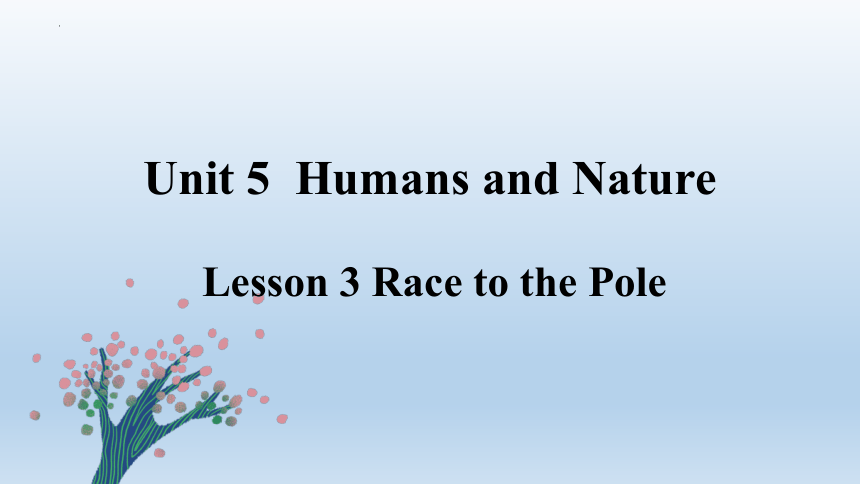 | |
| 格式 | pptx | ||
| 文件大小 | 13.0MB | ||
| 资源类型 | 教案 | ||
| 版本资源 | 北师大版(2019) | ||
| 科目 | 英语 | ||
| 更新时间 | 2023-03-07 17:27:04 | ||
图片预览

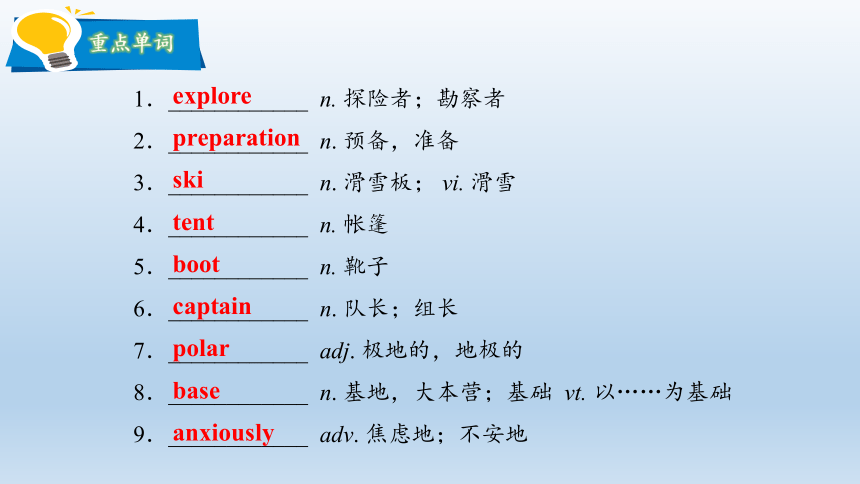

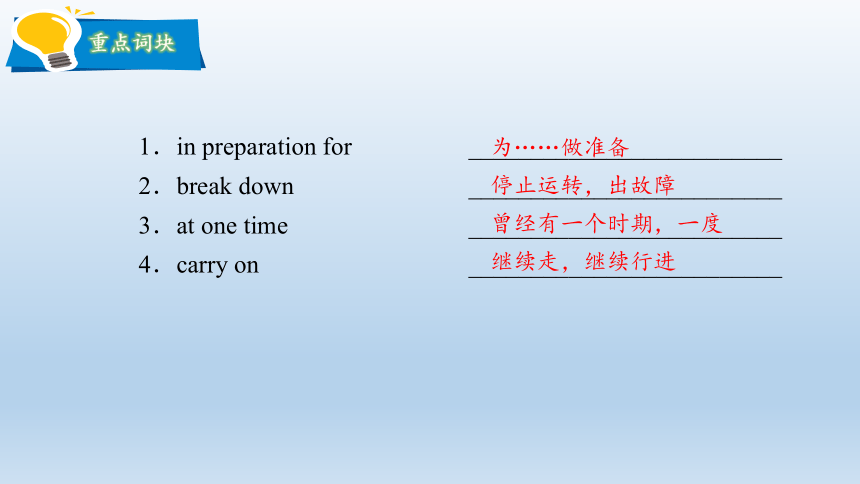

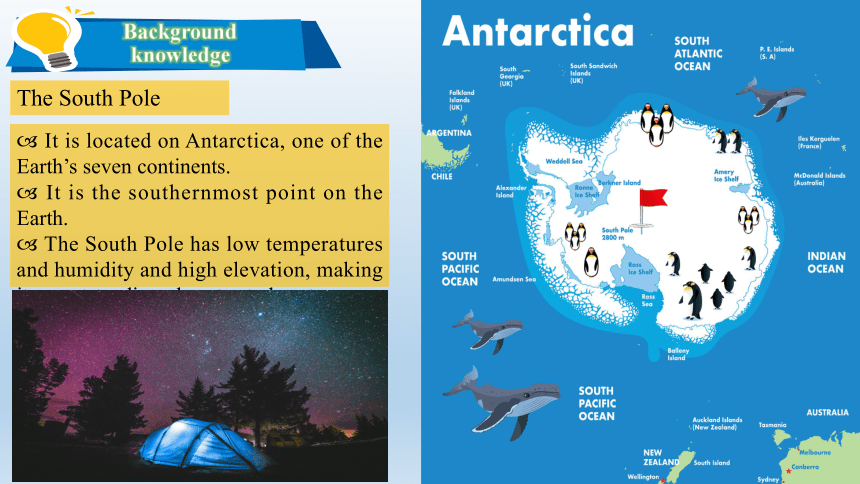
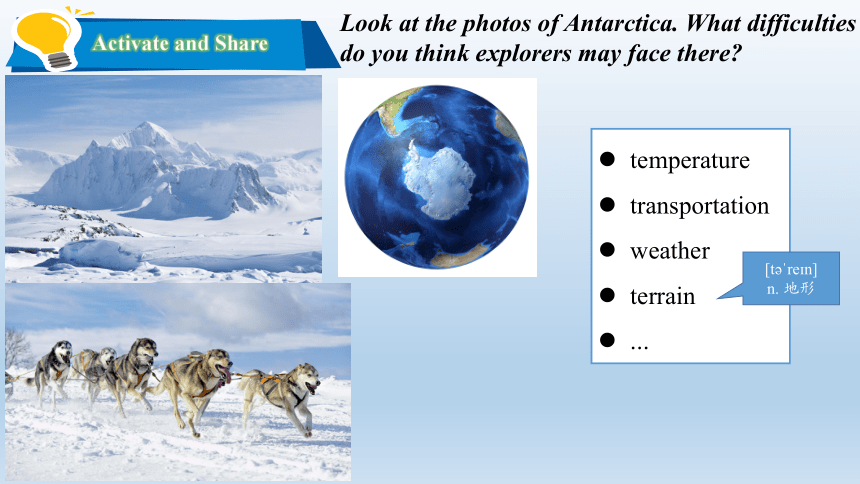
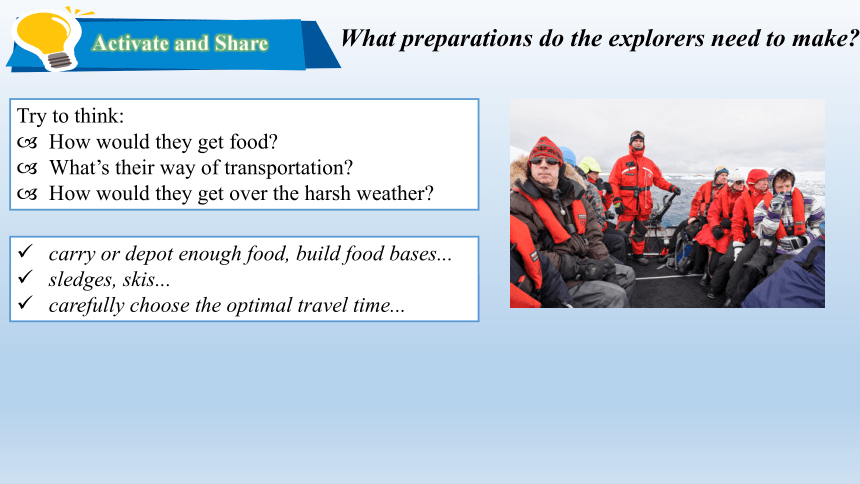

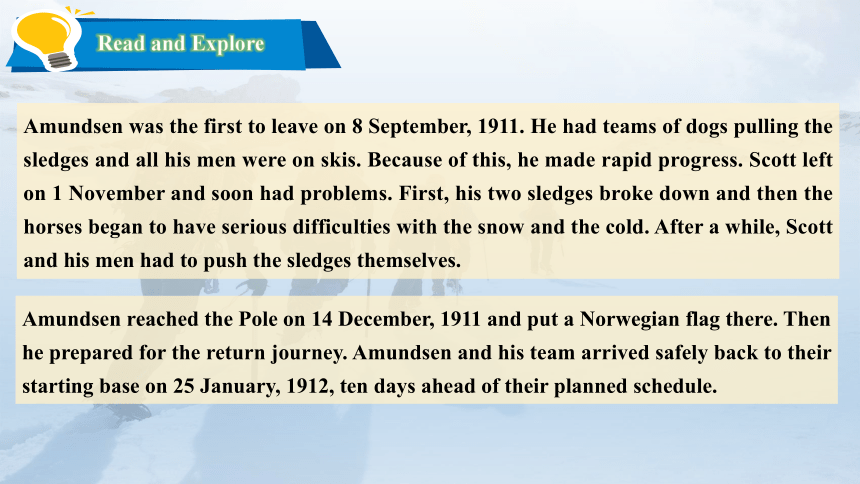

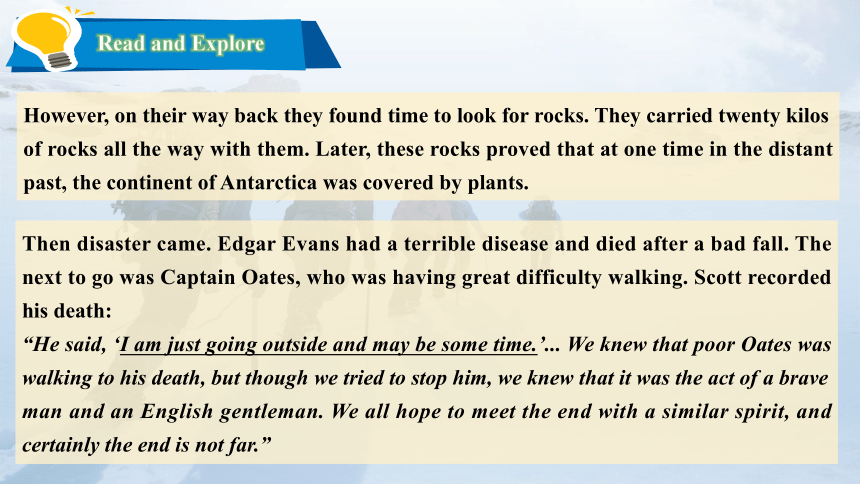
文档简介
(共33张PPT)
Unit 5 Humans and Nature
Lesson 3 Race to the Pole
重点单词
1.____________ n. 探险者;勘察者
2.____________ n. 预备,准备
3.____________ n. 滑雪板; vi. 滑雪
4.____________ n. 帐篷
5.____________ n. 靴子
6.____________ n. 队长;组长
7.____________ adj. 极地的,地极的
8.____________ n. 基地,大本营;基础 vt. 以……为基础
9.____________ adv. 焦虑地;不安地
explore
preparation
ski
tent
boot
captain
polar
base
anxiously
重点单词
10.____________ n. 抱负,雄心;追求,夙愿
11.____________ n. 探险;探索
12.____________ adj. 高兴的,兴高采烈的
13.____________ vt. 证明;证实
14.____________ adj. 久远的;遥远的
15.____________ n. 洲,大洲;大陆
16.____________ n. 坦诚;诚实,正直
17.____________ n. 真诚,真挚,诚实
18.____________ n. 勇气;勇敢的行为
ambition
exploration
cheerful
prove
distant
continent
honesty
sincerity
bravery
重点词块
1.in preparation for _________________________
2.break down _________________________
3.at one time _________________________
4.carry on _________________________
为……做准备
停止运转,出故障
曾经有一个时期,一度
继续走,继续行进
Background knowledge
Antarctica
It is the coldest and driest continent on the Earth, 90% of which is made of ice; it’s inhabited by penguins.
courage
strength in the face of fear
Background knowledge
The South Pole
It is located on Antarctica, one of the Earth’s seven continents.
It is the southernmost point on the Earth.
The South Pole has low temperatures and humidity and high elevation, making it an outstanding place to study astronomy.
Look at the photos of Antarctica. What difficulties do you think explorers may face there
Activate and Share
temperature
transportation
weather
terrain
...
[t re n]
n. 地形
What preparations do the explorers need to make
Activate and Share
Try to think:
How would they get food
What’s their way of transportation
How would they get over the harsh weather
carry or depot enough food, build food bases...
sledges, skis...
carefully choose the optimal travel time...
Here is an account of two teams’ journeys to the South Pole. Read the text and find out when the two journeys began and what happened to the two teams.
Read and Explore
On 1 June, 1910, Captain Robert Falcon Scott left London to begin his journey to Antarctica. While he was on the way to Antarctica, he received a message from the Norwegian explorer Roald Amundsen which said he was going south, too. Then the race to the South Pole began!
During the polar summer of 1910 — 1911, both teams organised food bases in preparation for their journeys the next year. Then came the total darkness of the polar winter. Scott and Amundsen waited anxiously for spring.
Read and Explore
Amundsen was the first to leave on 8 September, 1911. He had teams of dogs pulling the sledges and all his men were on skis. Because of this, he made rapid progress. Scott left on 1 November and soon had problems. First, his two sledges broke down and then the horses began to have serious difficulties with the snow and the cold. After a while, Scott and his men had to push the sledges themselves.
Amundsen reached the Pole on 14 December, 1911 and put a Norwegian flag there. Then he prepared for the return journey. Amundsen and his team arrived safely back to their starting base on 25 January, 1912, ten days ahead of their planned schedule.
Read and Explore
Scott finally arrived at the Pole with four team members on 17 January, 1912. They were shocked when they saw the Norwegian flag. Scott wrote in his diary:
“Well, we have now lost the goal of our ambition and must face 800 miles of hard pushing — and goodbye to most of our dreams.”
The return journey was one of the worst in the history of exploration. The men were soon very tired and were running out of food. The weather conditions were terrible. Scott started to realise their hopeless situation:
“We are very cheerful, but what each man feels in his heart I can only guess. Putting on our shoes in the morning is getting slower and slower.”
Read and Explore
However, on their way back they found time to look for rocks. They carried twenty kilos of rocks all the way with them. Later, these rocks proved that at one time in the distant past, the continent of Antarctica was covered by plants.
Then disaster came. Edgar Evans had a terrible disease and died after a bad fall. The next to go was Captain Oates, who was having great difficulty walking. Scott recorded his death:
“He said, ‘I am just going outside and may be some time.’... We knew that poor Oates was walking to his death, but though we tried to stop him, we knew that it was the act of a brave man and an English gentleman. We all hope to meet the end with a similar spirit, and certainly the end is not far.”
Read and Explore
Scott and two of his team members carried on and got within eleven miles of one of their food bases. But then a terrible storm started and they could not leave their tent. Scott spent some of his last hours writing. He wrote a letter full of sadness to his wife Kathleen:
“I could tell you lots and lots about this journey. What stories you would have for the boy ... but what a price to pay.”
Scott’s diary also told the story of their end:
“We are getting weaker and weaker and the end can’t be far. It seems a pity, but I do not think I can write more.”
Read and Explore
The news of Scott’s death shocked the world. Even Amundsen was moved by Scott’s death saying “Captain Scott left a record, for honesty, sincerity, for bravery, for everything that makes a man”. Scott had failed to win the race to the Pole, but the great courage shown by Scott and his men made them heroes.
Read again. Complete the information about the two exploration teams.
Read and Explore
Scott’s team Amundsen’s team
Nationality of the two teams
Before the journey
Journey to the destination
Arrival at the destination
The return journey
Read again. Complete the information about the two exploration teams.
Read and Explore
Scott’s team Amundsen’s team
Nationality of the two teams
Before the journey
Journey to the destination
British
Norwegian
They organised food bases.
They organised food bases.
Two sledges broke down. The horses had difficulties with the cold. Scott and his men had to push the sledges themselves.
He had teams of dogs pulling the sledges and all his men were on skis. Because of this, he made rapid progress.
Scott’s team Amundsen’s team
Arrival at the destination
The return journey
Scott arrived at the Pole with four team members on 17 January, 1912 and was disheartened.
Amundsen reached the Pole on 14 December, 1911 and put a Norwegian flag there. Then he prepared for the return journey.
Men were very tired and were running out of food.
The weather conditions were terrible.
They brought rocks back for scientific evaluation. All members died.
Amundsen and his team arrived safely back to their starting base on 25 January, 1912, ten days ahead of their planned schedule.
Read the underlined sentences from Scott’s diary and letter. Work out the implied meaning of the sentences.
Read and Explore
Sometimes things are not stated directly in the text. To understand what is meant, we need to read between the lines. This is called “making inferences”.
Read the sentence / paragraph carefully.
Read the lines before and after it.
Use your logic and knowledge to understand the implied meaning of the text.
Making inferences
Read the underlined sentences from Scott’s diary and letter. Work out the implied meaning of the sentences.
Read and Explore
Line 21 “Well, we have now lost the goal of our ambition and must face 800 miles of hard
pushing — and goodbye to most of our dreams.”
They lost the reason for the journey.
Line 26 The return journey was one of the worst in the history of exploration. The men
were soon very tired and were running out of food. The weather conditions were
terrible. Scott started to realise their hopeless situation:
“... We are very cheerful, but what each man feels in his heart I can only guess.
Putting on our shoes in the morning is getting slower and slower.”
The men were getting weaker.
Line 33 The next to go was Captain Oates, who was having great difficulty walking. Scott
recorded his death:
“He said, ‘I am just going outside and may be some time.’... We knew that poor
Oates was walking to his death, but though we tried to stop him, we knew that it
was the act of a brave man and an English gentleman. We all hope to meet the end
with a similar spirit, and certainly the end is not far.”
He is going to walk into the cold and die away from the team.
Line 42 Scott spent some of his last hours writing. He wrote a letter full of sadness to his
wife Kathleen:
“I could tell you lots and lots about this journey. What stories you would have for
the boy… but what a price to pay.”
The journey cost the men their lives.
Think and share.
Read and Explore
Even though Scott and his team lost the race to the Pole, they showed true determination and strength of character which is seen as in heroes. Scott and his team are inspirational and not losers. Scott’s team had always kept their goals in mind. They carried the rocks even in extremely difficult situations. The spirit and what they have done helped followers do further research.
Is Scott a loser in the race Why
Complete the Word Builder.
Focus on Language: SUFFIXES
1.prepare _____________
2.situate _____________
3.hope _____________
4.cheer _____________
5.explore _____________
6.anxious _____________
7.sad ___________
preparation
situation
hopeless
cheerful
exploration
anxiously
sadness
-tion
-less
-ful
-ness
-ly
Word Builder
Use the words in the Word Builder to complete the sentences.
Focus on Language: SUFFIXES
1. Scott and Amundsen waited anxiously for spring during the Antarctic winter of 1911.
2. Amundsen got to the South Pole before Scott because he had done more ___________
before leaving for the Pole.
3. Scott and his team got into a difficult ___________ because their sledges broke down.
4. Scott’s team tried to stay ________ despite of all the difficulties they faced.
5. Scott experienced a great sense of ________ after realising that all of his efforts to reach
the South Pole were for nothing.
6. Scott wrote about their ________ situation in his diary.
7. The bad weather increases the danger of their ___________.
situation
preparation
cheerful
sadness
hopeless
exploration
词汇精讲
1. (P36) Both teams organised food bases in preparation for their journeys the next year.
两支队伍都建了食品储备点,为来年的旅程做准备。
Careful preparation for the exam is essential. 认真准备考试十分必要。
The third book in the series is currently in preparation. 丛书的第三册现在正准备出版。
The team has been training hard in preparation for the big game.
为备战这场重要比赛,队伍一直在严格训练。
n. ~ (for sth) the act or process of getting ready for sth or making sth ready 准备;预备
preparation n. 预备,准备
The country is making preparations for war. 这个国家正在进行备战。
n. (usually pl. ) ~ (for sth) / ~ (to do sth) things that you do to get ready for sth or make sth ready
准备工作
We made preparations to move to new offices. 我们已准备好要搬到新办公室。
wedding preparations 婚礼的筹备工作
Was going to college a good preparation for your career
上大学是否为你的事业打下了良好基础?
用法提示:
(1)preparation用作不可数名词时表示“准备,预备”,常用于in preparation (for sth)短语中;
(2)用作可数名词时表示具体的“准备工作”,常与动词make连用,组成make preparations for。
词汇精讲
【针对练习】 完成句子/翻译句子
(1) ________________ the 2024 Olympic Games, he trains hard every day.
为准备2024年奥运会,他每天都刻苦训练。
(2) He didn’t ________________________ this exam, so he failed.
他没为这次考试做任何准备,所以没及格。
(3) 我们正为即将到来的考试作准备。
_______________________________________________________
In preparation for
make preparations for
We are making preparations for/preparing for the coming exam.
词汇精讲
2. (P36) During the polar summer of 1910-1911, both teams organised food bases in
preparation for their journeys the next year.
在1910—1911年的极地夏季,两支队伍都建了食品储备点,为来年的旅程作准备。
I spend a lot of time in Britain but Paris is still my base.
我有很多时间在英国度过,但主要还是居住在巴黎。
The town is an ideal base for touring the area.
这个镇子是在这一地区旅游观光的理想据点。
n. the main place where you live or stay or where a business operates from据点;总部;大本营
base n. 基地,大本营;基础 vt. 以……为基地
The company has its base in New York, and branch offices all over the world.
公司总部设在纽约,分支遍及全世界。
a military/naval base 军事/海军基地
an air base 空军基地
After the attack, they returned to the base. 他们发动攻击之后返回了基地。
n. a place where an army, a navy, etc. operates from 基地
vt. ~ sb/sth/yourself in...: to use a particular city, town, etc. as the main place for a business,
holiday/vacation, etc. 以……为据点(或总部等);把(总部等)设在
We’re going to base ourselves in Tokyo and make trips from there.
我们将以东京为据点到各地旅行。
vt. base sth on/upon sth: to use an idea, a fact, a situation, etc. as the point from which sth can be
developed 以……为基础(或根据)
You should base your conclusion on/upon careful research.
你应该以审慎的研究为基础而下结论。
The movie is based on/upon the popular novel of the same name.
这部电影是以同名人气小说为基础(改编)的。
词汇精讲
【针对练习】 完成句子/翻译句子
(1) Three of the new products ____________ on traditional herbal medicines.
新产品中有三种是根据传统草药研制的。
(2) The two hotels are attractive _________________________ southeast Tuscany.
这两个旅馆是去托斯卡纳东南探险最有吸引力的大本营。
(3) 医患关系是以信任为基础的。(be based on)
______________________________________________
are based
bases from which to explore
The doctor-patient relationship is based on trust.
句子精讲
3. (P36) Then came the total darkness of the polar winter.
接着极地的冬季来临了,四周一片黑暗。
该句为完全倒装语序,主语为the total darkness of the polar winter, 谓语为came。
【句式学习】
表示地点的副词here,there,up,down,out,in,away;表示时间的副词now,then;表语以及表示地点的介词短语位于句首时,句子用完全倒装。
完全倒装句中的谓语动词常是系动词be或come,go,lie,stand等不及物动词,且主语是名词。
例句学习
例1. _____________ the bus.
公共汽车来了。
例2. _____________ the headmaster.
校长进来了。
例3. _________________ when we were looked down upon.
我们被瞧不起的日子一去不复返了。
例4. _________________ a tall tree.
院子里有一棵大树。
Here comes
In came
Gone are the days
In the yard stands
用法提醒:
(1)这种完全倒装结构的时态只限于一般现在时或一般过去时。
(2)谓语动词的单复数视后面主语的单复数而定。
句子精讲
【针对练习】 用完全倒装结构完成下列句子
(1)At the foot of the mountain ________________ (住着一位老人).
(2)Out ________________ (一条大狗冲了出来).
(3)North of the village ________________ (流淌着一条河).
lives an old man
rushed a big dog
lies a river
Thank You
Unit 5 Humans and Nature
Lesson 3 Race to the Pole
重点单词
1.____________ n. 探险者;勘察者
2.____________ n. 预备,准备
3.____________ n. 滑雪板; vi. 滑雪
4.____________ n. 帐篷
5.____________ n. 靴子
6.____________ n. 队长;组长
7.____________ adj. 极地的,地极的
8.____________ n. 基地,大本营;基础 vt. 以……为基础
9.____________ adv. 焦虑地;不安地
explore
preparation
ski
tent
boot
captain
polar
base
anxiously
重点单词
10.____________ n. 抱负,雄心;追求,夙愿
11.____________ n. 探险;探索
12.____________ adj. 高兴的,兴高采烈的
13.____________ vt. 证明;证实
14.____________ adj. 久远的;遥远的
15.____________ n. 洲,大洲;大陆
16.____________ n. 坦诚;诚实,正直
17.____________ n. 真诚,真挚,诚实
18.____________ n. 勇气;勇敢的行为
ambition
exploration
cheerful
prove
distant
continent
honesty
sincerity
bravery
重点词块
1.in preparation for _________________________
2.break down _________________________
3.at one time _________________________
4.carry on _________________________
为……做准备
停止运转,出故障
曾经有一个时期,一度
继续走,继续行进
Background knowledge
Antarctica
It is the coldest and driest continent on the Earth, 90% of which is made of ice; it’s inhabited by penguins.
courage
strength in the face of fear
Background knowledge
The South Pole
It is located on Antarctica, one of the Earth’s seven continents.
It is the southernmost point on the Earth.
The South Pole has low temperatures and humidity and high elevation, making it an outstanding place to study astronomy.
Look at the photos of Antarctica. What difficulties do you think explorers may face there
Activate and Share
temperature
transportation
weather
terrain
...
[t re n]
n. 地形
What preparations do the explorers need to make
Activate and Share
Try to think:
How would they get food
What’s their way of transportation
How would they get over the harsh weather
carry or depot enough food, build food bases...
sledges, skis...
carefully choose the optimal travel time...
Here is an account of two teams’ journeys to the South Pole. Read the text and find out when the two journeys began and what happened to the two teams.
Read and Explore
On 1 June, 1910, Captain Robert Falcon Scott left London to begin his journey to Antarctica. While he was on the way to Antarctica, he received a message from the Norwegian explorer Roald Amundsen which said he was going south, too. Then the race to the South Pole began!
During the polar summer of 1910 — 1911, both teams organised food bases in preparation for their journeys the next year. Then came the total darkness of the polar winter. Scott and Amundsen waited anxiously for spring.
Read and Explore
Amundsen was the first to leave on 8 September, 1911. He had teams of dogs pulling the sledges and all his men were on skis. Because of this, he made rapid progress. Scott left on 1 November and soon had problems. First, his two sledges broke down and then the horses began to have serious difficulties with the snow and the cold. After a while, Scott and his men had to push the sledges themselves.
Amundsen reached the Pole on 14 December, 1911 and put a Norwegian flag there. Then he prepared for the return journey. Amundsen and his team arrived safely back to their starting base on 25 January, 1912, ten days ahead of their planned schedule.
Read and Explore
Scott finally arrived at the Pole with four team members on 17 January, 1912. They were shocked when they saw the Norwegian flag. Scott wrote in his diary:
“Well, we have now lost the goal of our ambition and must face 800 miles of hard pushing — and goodbye to most of our dreams.”
The return journey was one of the worst in the history of exploration. The men were soon very tired and were running out of food. The weather conditions were terrible. Scott started to realise their hopeless situation:
“We are very cheerful, but what each man feels in his heart I can only guess. Putting on our shoes in the morning is getting slower and slower.”
Read and Explore
However, on their way back they found time to look for rocks. They carried twenty kilos of rocks all the way with them. Later, these rocks proved that at one time in the distant past, the continent of Antarctica was covered by plants.
Then disaster came. Edgar Evans had a terrible disease and died after a bad fall. The next to go was Captain Oates, who was having great difficulty walking. Scott recorded his death:
“He said, ‘I am just going outside and may be some time.’... We knew that poor Oates was walking to his death, but though we tried to stop him, we knew that it was the act of a brave man and an English gentleman. We all hope to meet the end with a similar spirit, and certainly the end is not far.”
Read and Explore
Scott and two of his team members carried on and got within eleven miles of one of their food bases. But then a terrible storm started and they could not leave their tent. Scott spent some of his last hours writing. He wrote a letter full of sadness to his wife Kathleen:
“I could tell you lots and lots about this journey. What stories you would have for the boy ... but what a price to pay.”
Scott’s diary also told the story of their end:
“We are getting weaker and weaker and the end can’t be far. It seems a pity, but I do not think I can write more.”
Read and Explore
The news of Scott’s death shocked the world. Even Amundsen was moved by Scott’s death saying “Captain Scott left a record, for honesty, sincerity, for bravery, for everything that makes a man”. Scott had failed to win the race to the Pole, but the great courage shown by Scott and his men made them heroes.
Read again. Complete the information about the two exploration teams.
Read and Explore
Scott’s team Amundsen’s team
Nationality of the two teams
Before the journey
Journey to the destination
Arrival at the destination
The return journey
Read again. Complete the information about the two exploration teams.
Read and Explore
Scott’s team Amundsen’s team
Nationality of the two teams
Before the journey
Journey to the destination
British
Norwegian
They organised food bases.
They organised food bases.
Two sledges broke down. The horses had difficulties with the cold. Scott and his men had to push the sledges themselves.
He had teams of dogs pulling the sledges and all his men were on skis. Because of this, he made rapid progress.
Scott’s team Amundsen’s team
Arrival at the destination
The return journey
Scott arrived at the Pole with four team members on 17 January, 1912 and was disheartened.
Amundsen reached the Pole on 14 December, 1911 and put a Norwegian flag there. Then he prepared for the return journey.
Men were very tired and were running out of food.
The weather conditions were terrible.
They brought rocks back for scientific evaluation. All members died.
Amundsen and his team arrived safely back to their starting base on 25 January, 1912, ten days ahead of their planned schedule.
Read the underlined sentences from Scott’s diary and letter. Work out the implied meaning of the sentences.
Read and Explore
Sometimes things are not stated directly in the text. To understand what is meant, we need to read between the lines. This is called “making inferences”.
Read the sentence / paragraph carefully.
Read the lines before and after it.
Use your logic and knowledge to understand the implied meaning of the text.
Making inferences
Read the underlined sentences from Scott’s diary and letter. Work out the implied meaning of the sentences.
Read and Explore
Line 21 “Well, we have now lost the goal of our ambition and must face 800 miles of hard
pushing — and goodbye to most of our dreams.”
They lost the reason for the journey.
Line 26 The return journey was one of the worst in the history of exploration. The men
were soon very tired and were running out of food. The weather conditions were
terrible. Scott started to realise their hopeless situation:
“... We are very cheerful, but what each man feels in his heart I can only guess.
Putting on our shoes in the morning is getting slower and slower.”
The men were getting weaker.
Line 33 The next to go was Captain Oates, who was having great difficulty walking. Scott
recorded his death:
“He said, ‘I am just going outside and may be some time.’... We knew that poor
Oates was walking to his death, but though we tried to stop him, we knew that it
was the act of a brave man and an English gentleman. We all hope to meet the end
with a similar spirit, and certainly the end is not far.”
He is going to walk into the cold and die away from the team.
Line 42 Scott spent some of his last hours writing. He wrote a letter full of sadness to his
wife Kathleen:
“I could tell you lots and lots about this journey. What stories you would have for
the boy… but what a price to pay.”
The journey cost the men their lives.
Think and share.
Read and Explore
Even though Scott and his team lost the race to the Pole, they showed true determination and strength of character which is seen as in heroes. Scott and his team are inspirational and not losers. Scott’s team had always kept their goals in mind. They carried the rocks even in extremely difficult situations. The spirit and what they have done helped followers do further research.
Is Scott a loser in the race Why
Complete the Word Builder.
Focus on Language: SUFFIXES
1.prepare _____________
2.situate _____________
3.hope _____________
4.cheer _____________
5.explore _____________
6.anxious _____________
7.sad ___________
preparation
situation
hopeless
cheerful
exploration
anxiously
sadness
-tion
-less
-ful
-ness
-ly
Word Builder
Use the words in the Word Builder to complete the sentences.
Focus on Language: SUFFIXES
1. Scott and Amundsen waited anxiously for spring during the Antarctic winter of 1911.
2. Amundsen got to the South Pole before Scott because he had done more ___________
before leaving for the Pole.
3. Scott and his team got into a difficult ___________ because their sledges broke down.
4. Scott’s team tried to stay ________ despite of all the difficulties they faced.
5. Scott experienced a great sense of ________ after realising that all of his efforts to reach
the South Pole were for nothing.
6. Scott wrote about their ________ situation in his diary.
7. The bad weather increases the danger of their ___________.
situation
preparation
cheerful
sadness
hopeless
exploration
词汇精讲
1. (P36) Both teams organised food bases in preparation for their journeys the next year.
两支队伍都建了食品储备点,为来年的旅程做准备。
Careful preparation for the exam is essential. 认真准备考试十分必要。
The third book in the series is currently in preparation. 丛书的第三册现在正准备出版。
The team has been training hard in preparation for the big game.
为备战这场重要比赛,队伍一直在严格训练。
n. ~ (for sth) the act or process of getting ready for sth or making sth ready 准备;预备
preparation n. 预备,准备
The country is making preparations for war. 这个国家正在进行备战。
n. (usually pl. ) ~ (for sth) / ~ (to do sth) things that you do to get ready for sth or make sth ready
准备工作
We made preparations to move to new offices. 我们已准备好要搬到新办公室。
wedding preparations 婚礼的筹备工作
Was going to college a good preparation for your career
上大学是否为你的事业打下了良好基础?
用法提示:
(1)preparation用作不可数名词时表示“准备,预备”,常用于in preparation (for sth)短语中;
(2)用作可数名词时表示具体的“准备工作”,常与动词make连用,组成make preparations for。
词汇精讲
【针对练习】 完成句子/翻译句子
(1) ________________ the 2024 Olympic Games, he trains hard every day.
为准备2024年奥运会,他每天都刻苦训练。
(2) He didn’t ________________________ this exam, so he failed.
他没为这次考试做任何准备,所以没及格。
(3) 我们正为即将到来的考试作准备。
_______________________________________________________
In preparation for
make preparations for
We are making preparations for/preparing for the coming exam.
词汇精讲
2. (P36) During the polar summer of 1910-1911, both teams organised food bases in
preparation for their journeys the next year.
在1910—1911年的极地夏季,两支队伍都建了食品储备点,为来年的旅程作准备。
I spend a lot of time in Britain but Paris is still my base.
我有很多时间在英国度过,但主要还是居住在巴黎。
The town is an ideal base for touring the area.
这个镇子是在这一地区旅游观光的理想据点。
n. the main place where you live or stay or where a business operates from据点;总部;大本营
base n. 基地,大本营;基础 vt. 以……为基地
The company has its base in New York, and branch offices all over the world.
公司总部设在纽约,分支遍及全世界。
a military/naval base 军事/海军基地
an air base 空军基地
After the attack, they returned to the base. 他们发动攻击之后返回了基地。
n. a place where an army, a navy, etc. operates from 基地
vt. ~ sb/sth/yourself in...: to use a particular city, town, etc. as the main place for a business,
holiday/vacation, etc. 以……为据点(或总部等);把(总部等)设在
We’re going to base ourselves in Tokyo and make trips from there.
我们将以东京为据点到各地旅行。
vt. base sth on/upon sth: to use an idea, a fact, a situation, etc. as the point from which sth can be
developed 以……为基础(或根据)
You should base your conclusion on/upon careful research.
你应该以审慎的研究为基础而下结论。
The movie is based on/upon the popular novel of the same name.
这部电影是以同名人气小说为基础(改编)的。
词汇精讲
【针对练习】 完成句子/翻译句子
(1) Three of the new products ____________ on traditional herbal medicines.
新产品中有三种是根据传统草药研制的。
(2) The two hotels are attractive _________________________ southeast Tuscany.
这两个旅馆是去托斯卡纳东南探险最有吸引力的大本营。
(3) 医患关系是以信任为基础的。(be based on)
______________________________________________
are based
bases from which to explore
The doctor-patient relationship is based on trust.
句子精讲
3. (P36) Then came the total darkness of the polar winter.
接着极地的冬季来临了,四周一片黑暗。
该句为完全倒装语序,主语为the total darkness of the polar winter, 谓语为came。
【句式学习】
表示地点的副词here,there,up,down,out,in,away;表示时间的副词now,then;表语以及表示地点的介词短语位于句首时,句子用完全倒装。
完全倒装句中的谓语动词常是系动词be或come,go,lie,stand等不及物动词,且主语是名词。
例句学习
例1. _____________ the bus.
公共汽车来了。
例2. _____________ the headmaster.
校长进来了。
例3. _________________ when we were looked down upon.
我们被瞧不起的日子一去不复返了。
例4. _________________ a tall tree.
院子里有一棵大树。
Here comes
In came
Gone are the days
In the yard stands
用法提醒:
(1)这种完全倒装结构的时态只限于一般现在时或一般过去时。
(2)谓语动词的单复数视后面主语的单复数而定。
句子精讲
【针对练习】 用完全倒装结构完成下列句子
(1)At the foot of the mountain ________________ (住着一位老人).
(2)Out ________________ (一条大狗冲了出来).
(3)North of the village ________________ (流淌着一条河).
lives an old man
rushed a big dog
lies a river
Thank You
同课章节目录
- Unit 4 Information technology
- Lesson 1 Avatars
- Lesson 2 Apps
- Lesson 3 Internet and Friendships
- Unit 5 Humans and nature
- Lesson 1 A Sea Story
- Lesson 2 Professional Rescue Team
- Lesson 3 Race to the Pole
- Unit 6 The admirable
- Lesson 1 A Medical Pioneer
- Lesson 2 History Makers
- Lesson 3 The Superhero Behind Superman
